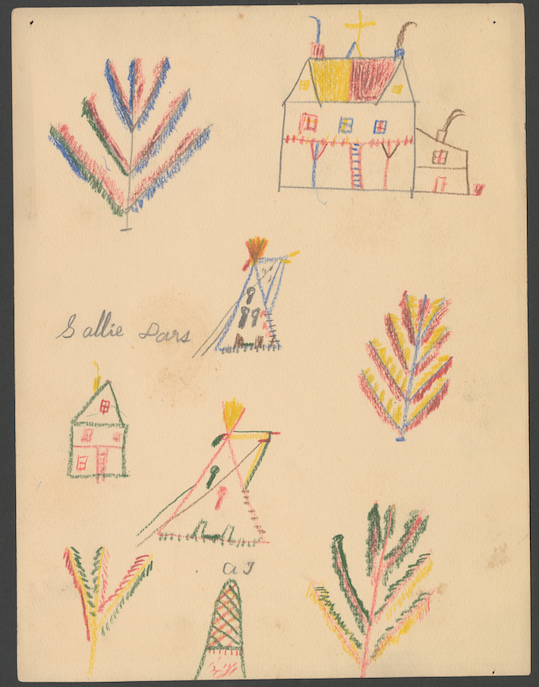By Sofia Buziashvili
Due to the way history courses are taught and the lack of personal experience most non-Natives have in interacting with Native Americans, there is minimal focus on their cultural importance in modern American society. The “Rainy Mountain Boarding School drawings” from the Hilon A. Parker family papers feature an array of drawings created by Kiowa children at the Rainy Mountain Boarding School in Oklahoma. The ones selected for our exhibit feature scenes of everyday Native life. The children drew these scenes to thank Parker for their train ride to school; however, they evoke feelings of nostalgia and longing for the families and communities that the Rainy Mountain boarding school separated them from. The “Rainy Mountain Boarding School drawings” from 1899 reveal the persistence of Kiowa children’s ties to their culture and land despite their forced assimilation into white society at the boarding school.


Through an analysis of the drawings and oral histories of Rainy Mountain boarding school survivors, it becomes evident that Native culture is still alive and thriving. Life at the Rainy Mountain Boarding School was quite harsh. Boarding school survivors noted that they wore “‘prison clothes and didn’t know it’” (Ellis 781) and were punished for “‘Everything [they did]’” (Ellis 782). Children lived in military-like conditions with strict schedules and rules. Schools like Rainy Mountain worked hard to suppress any attempts of the children to hold onto their Kiowa identity, seeking to mold the children into “civilized” Americans who would be able to succeed in mainstream society. Children defied such attempts by sneaking around, running away, and secretly disobeying the rules of the school in an attempt to feel like real people. These drawings evoke sadness and sympathy in viewers, as one can see how the Native American children had no say in the course of their lives. Although these are drawn by children, this is still a reliable way to piece together the experience of Native American assimilation.


Drawing attention to the students who created the drawings, they received a visit from Hilon A. Parker, whose interest in the school appears to be far from a coincidence with the given time. During this period of westward expansion and establishment of Anglo-American culture throughout the United States, people sought a way to physically connect people, ideas, and resources through none other than a railroad. Parker most likely wanted to see the school and gain a feeling of where his railroad would soon pass through. Taking the children on a trip on the railroad was the most convenient way to do so, and the thank-you notes that followed have created a window to a first-hand understanding and view of assimilation of Native American children in the process.
The “Rainy Mountain Boarding School drawings” serve as a way to get into the minds of children who were forced to leave behind their lives, and attempt to grasp the challenges that they faced. As a heavily exploited minority group, Natives had to work harder to hold onto their identity. During the use of boarding schools and attempts to remove Native Americans from their land, reservations were successfully created, unfortunately only adding to the suffering that Native Americans faced. As tragic as the experiences of the Native American children were at the boarding school, however, it is important to recognize that Rainy Mountain did not cause the extinction of Native culture and instead Kiowa people used their experiences to build solidarity with other Native groups.


References:
Kiowa schoolchildren, Hilton A. Parker family papers, “Rainy Mountain Boarding School drawings” (1899), William L. Clements Library, Ann Arbor, Mich.
Ellis, Clyde. “Boarding School Life at the Kiowa-Comanche Agency, 1893-1920.” The Historian (Kingston), vol. 58, no. 4, Oxford, UK: Taylor & Francis, pp. 777–93.
